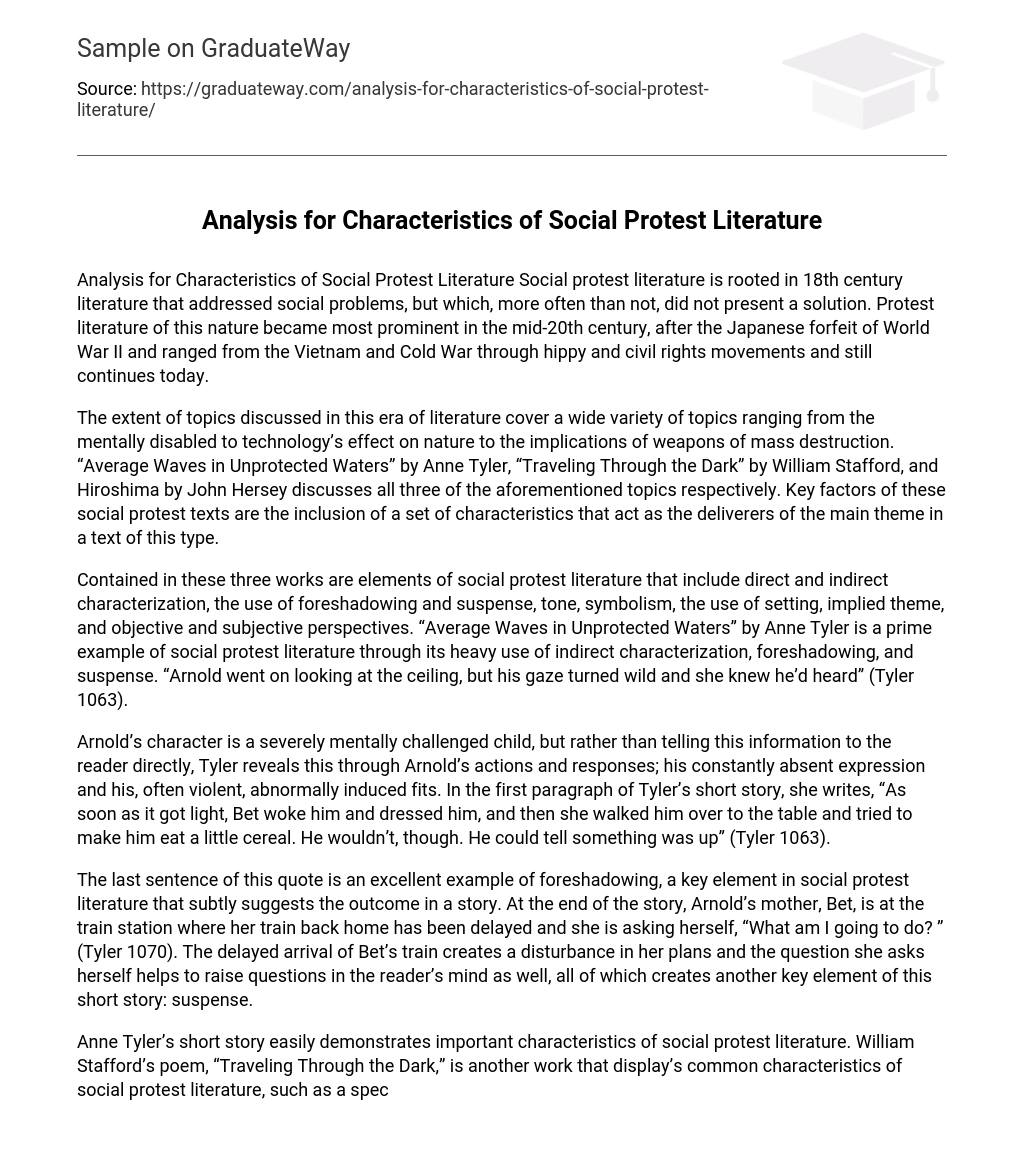Social protest literature, which emerged in the 18th century, is a type of literature that discusses social issues without necessarily offering solutions. Its importance increased greatly following Japan’s surrender in World War II and during subsequent events such as the Vietnam War, Cold War, hippie movement, civil rights movement. It remains relevant today.
In this time period, various literary works explore different topics including the mentally disabled, the influence of technology on nature, and the outcomes of weapons of mass destruction. Notably, Anne Tyler’s “Average Waves in Unprotected Waters,” William Stafford’s “Traveling Through the Dark,” and John Hersey’s Hiroshima all address one of these particular subjects. These texts function as forms of social protest and possess unique characteristics that effectively communicate their main message.
These three works exemplify social protest literature through the utilization of various literary techniques such as direct and indirect characterization, foreshadowing and suspense, tone, symbolism, setting, implied theme, and objective and subjective perspectives. One prime example of social protest literature is “Average Waves in Unprotected Waters” by Anne Tyler. This work prominently features indirect characterization, foreshadowing, and suspense. For instance, there is a moment when Arnold’s gaze suddenly turns wild upon hearing something (Tyler 1063).
Arnold’s character is depicted as having significant mental impairment, which the author, Tyler, subtly reveals through his actions and responses. Arnold frequently wears a vacant expression and exhibits violent outbursts, indicative of his abnormal state. In the opening paragraph of Tyler’s short story, she describes how Bet wakes him up and gets him dressed, before attempting to feed him cereal at the table. However, Arnold refuses to eat, as he instinctively detects that something is amiss” (Tyler 1063).
The final line in this quote offers a strong instance of foreshadowing, an important element in social protest literature which hints at the story’s outcome. In the conclusion, Bet, Arnold’s mother, is situated at the train station where her return train has been postponed. Bet contemplates, “What am I going to do?” (Tyler 1070). The delayed arrival of Bet’s train disrupts her plans and leaves the reader pondering. This introduces another crucial aspect of this short story: suspense.
Both Anne Tyler’s short story and William Stafford’s poem exemplify key elements of social protest literature. Tyler’s story carries similar traits to Stafford’s poem, such as a distinct tone, potent symbolism, and an impactful setting. In Stafford’s work, he utilizes a deliberately straightforward language to depict an incident that would typically elicit minimal attention. As evidenced by his words, “I dragged her off; she was large in the belly” (Stafford 1054), Stafford creates discomfort and provokes thought.
Stafford uses unsettling yet captivating language to establish a somber and weighty mood that conveys the profound meaning hidden beneath his deceptively straightforward words. Despite its concise length, the poem delves into the importance of both the car and the dead doe on the side of the road (Stafford 1053). By employing symbolism, a prominent characteristic of social protest literature, Stafford investigates the detrimental effects of human industry and technology on the natural world. The deer and car in his poem serve as symbols of this destructive impact.
The initial four lines of the poem establish the setting: while journeying through darkness, I came upon a deceased deer by the side of the Wilson River road. It is typically advised to push them into the canyon as that road is narrow, avoiding any chances of causing more deaths” (Stafford 1053). The importance of setting in this poem, like in any other piece of literature, should not be underestimated. Without it, a great deal of the gloominess and gravity initially depicted would vanish.
William Stafford’s poem establishes the criteria for literary components essential in social protest writings. In John Hersey’s novel, Hiroshima, he further exemplifies the features of social protest literature, such as implicit themes, objective versus subjective viewpoints, and direct portrayal of characters. Hersey’s book chronicles the firsthand recollections of various Japanese individuals who endured the destructive impact of the atomic bomb that devastated Hiroshima in World War II (Hersey 1199).
The reason for sharing personal accounts of the blast is to show the reader that the Japanese people were deeply affected by this tragedy. These stories portray the extensive damage caused by the bombing, which is a recurring theme in the novel. Instead of expressing his own views, Hersey presents factual reports and firsthand experiences of the individuals impacted (Hersey 1199).
The author’s writing of the novel offers an unbiased viewpoint on the bombing of Hiroshima by using an objective perspective. This approach ensures that personal thoughts and feelings are absent from the text, in contrast to a subjective perspective. The novel commences by furnishing details about individuals who will be further explored in the subsequent section: a hundred thousand individuals lost their lives due to the atomic bomb, and these [four] individuals were fortunate survivors. Despite numerous deaths, they continue to question the reason behind their survival.
Every survivor encountered multiple occurrences of luck or choice. These included things like timing a step correctly, opting to seek shelter indoors, or boarding a specific streetcar instead of another. Despite appearing insignificant, these choices turned out to be vital in preserving their lives. In retrospect, each survivor acknowledges that their act of survival exposed them to an unimaginable amount of death. However, at the time, none of them fully grasped the gravity of their decisions. This quote from Hersey’s work exemplifies the utilization of direct characterization in social protest literature.
John Hersey is a prominent figure in social protest literature, as evidenced in works like Hiroshima. The three examined texts effectively and distinctly exhibit important aspects of social protest literature. Texts regarding individuals with mental disabilities, the clash between nature and human technology, and the utilization of immensely destructive weapons naturally employ these characteristics to classify them within this genre. Through the application of various literary elements, any type of text has the potential to be transformed into a work of social protest.





